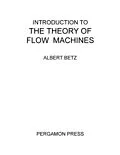Introduction to the Theory of Flow Machines details the fundamental processes and the relations that have a significant influence in the operating mechanism of flow machines. The book first covers the general consideration in flow machines, such as pressure, stress, and cavitation. In the second chapter, the text deals with ducts; this chapter discusses the general remarks, types of flow, and mixing process. Next, the book tackles the types of cascades, along with its concerns. The closing chapter covers the flow machine and its components, such as turbine, wheels, engines, and propellers. The text will be of great use to mechanical engineers and technicians.
Inhalt
Foreword
Preface to the English Edition
A. General Considerations
1. Static and Dynamic Energy Transfer
Transmission of Force by Pistons or by Movement of Aerofoils and Cascades
2. Purposes and Classification of Flow Machines
Machines That Supply Energy to the Fluid and Those That Extract Energy from It
Energy Transmission
Machines with Pressure Fall and Those with Pressure Rise
Ducted and Non-Ducted Machines
Axial, Radial, and Diagonal Forms of Construction
3. Some Geometrical Concepts
Steady and Unsteady Processes
Streamlines and Particle Paths
Plane ad Three-Dimensional Flows
Two-Dimensional Flows
4. Pressure
Pressure in a Fluid at Rest
Dependence of Specific Gravity and Density on Pressure and Temperature
Compressible and Incompressible Fluids
Gas Constant
5. Adiabatic Changes of State
Relations between Temperature, Pressure, Density, and Specific Gravity for Processes Involving No Heat Exchange
6. Shear Stress
Forces associated with Deformation
Viscosity
Kinematic Viscosity
7. Bernoulli's Equation
Dependence of Pressure on Height and Speed
Reduction to a Reference Height
Total Pressure, Static Pressure, Dynamic Pressure
Acceleration Term in Unsteady Flows
Relations between Variables of State for Ideal Compressible Fluids
Speed of Sound
Critical Speed
8. Cavitation
Critical Pressure
Cavitation Number
Highest Permissible Speed
Effect on Efficiency
Destruction of the Material of the Wall
9. Potential Flow, Rotation, Circulation
B. Ducts
Formation and Properties of Potential Flows
Irrotationality
Parallel Flow, Source, Vortex
Circulation and Lift (Kutta-Joukowsky Theorem)
Concept of Circulation for Aerofoils with Wakes
Behavior of the Energy in a Vortex Field
10. General Remarks
Inlet Flow and Fully Established Pipe Flow
Volume and Mass Flow Rates
Mean Flow Velocity
11. Types of Flow; Reynolds Number
Laminar and Turbulent Flow
Critical Reynolds Number
Equivalent Diameter
12. Laminar Flow
Velocity Distribution in Pipe and Gap
Pressure Fall and Resistance Coefficients for Circular and Rectangular Cross-Sections
13. Turbulent Flow
Velocity Distribution and Pressure Fall in Smooth Pipes
Rough Walls
Sand Roughness
Pressure Fall and Velocity Distribution in Rough Pipes
Behavior of Flow in Non-Circular Cross-Sections
14. Conditions in the Inlet
Displacement Thickness
Momentum Thickness
Transition from Laminar to Turbulent Boundary-Layer Flow
Critical Boundary Layer Thickness, and Position of Transition Point
Growth of Laminar and Turbulent Boundary Layers
Similarity
15. Changes in Cross-Section
Change with Cross-Section of the Mean Velocity, of the Velocity Distribution across the Cross-Section, and of the Pressure
Phenomena in Expanding Ducts (Diffusera)
Boundary-Layer Separation
Reduction in Pressure Rise (Diffuser Effect) with Non-Uniform Velocity Distribution
Efficiency of Diffusera
Favorable Effects of Bodies Producing Extra Resistance or of Rotors at End of Diffuser, of Boundary-Layer Suction, and of Swirl in the Flow Core of Dead Water
16. Mixing Processes
Pressure Rise and Energy Loss associated with Mixing
Mixing of Two Streams of Different Velocity
Sudden Expansion of a Duct
Diffuser in Front of and behind a Mixing Process
Combustion Processes
17. Curved Ducts
Stable and Unstable Velocity Distributions
Forces on Channel Walls
Behavior of the Boundary Layer
Secondary Flow
Energy Loss in Elbows for Turbulent and Lamina Reflow
Reduction of Losses by Stators or by Cross-Sections in Which One Dimension is Much Larger than the Other
18. Behavior of Compressible Fluids; Laval Nozzle; Shock Waves
Speed of Sound
Critical Speed
Laval Nozzles
Propagation of Disturbances in Subsonic and Supersonic Flow
Mach Lines
Mach Number
Normal and Oblique Shock Waves
19. Behavior of a Gas Flow with Addition and Removal of Heat
Consequences of Continuity Equation
Temperature and Velocity Changes in Subsonic and Supersonic Flow
Temperature Maximum
20. Flow through Ducts in Rotating Rotors
Unsteady Potential Flow or Steady Flow with Constant Rotation
Straight and Curved Ducts without and with Expansion of Cross-Sections
Point of Reversal of Velocity
Separation Lines between Flow Passing through and Flow Coming from outside and Returning outside
Coriolis Forces
Increased Danger of Boundary-Layer Separation
Secondary Flow
21. Variable Volume Flow Rate; Hydraulic Ram
Pressures When the Flow through the Duct is Accelerated or Retarded
Speed of Propagation of Pressure Waves in Ducts with Elastic Walls
Reflection of Pressure Waves at Points Where the Speed of Propagation Changes or Where the Cross-Section Changes
Pressure Fluctuations at a Throttle Point
Possible Damage to the Duct from the Pressure Fluctuations, and Means of Reducing The Danger
Use of the Pressure Fluctuations in the Hydraulic Ram
C. Cascades
22. Straight and Circular Cascades
Concept, Properties, and Purposes of a Cascade
Impulse, Turbine, and Compressor Cascades
23. Deflection without Losses through a Straight Cascade
Behavior of Velocity Components in the Cascade Direction and Normal to This Direction, and Behavior of Pressure
Peculiarities of Compressible Fluids
Forces on the Blades
Power and Energy Change for Incompressible and Compressible Fluids
24. Deflection without Losses through a Circular Cascade
Behavior of Velocity Components and Pressure for Incompressible and Compressible Fluids
Power and Energy Change
25. Investigation of Losses
Efficiency of a Cascade
Shaft Efficiency
Relations for Compressible Fluids
26. The Shape and Arrangement of the Blades
Blades Far Apart from One Another and Those Close Together
Processes at a Moderate Blade Spacing
27. Cascades with Blades Very Close Together
Velocity and the Distribution of Circulation as Functions of Slope of Blade
Effect of Curvature of Channel
Effect of Thicknesses of Blade and Boundary Layer
28. Conditions at the Discharge End of the Blade
Deviation of Flow Direction from Blade Slope at Discharge End
Rotating Cascades with Radial Flow
29. Conditions …
